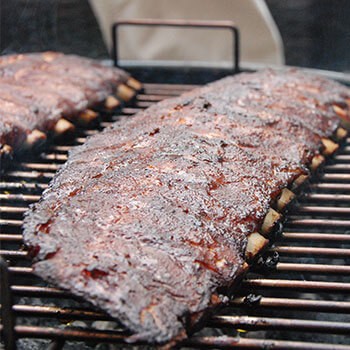
How To Get Bark When Smoking Meat
Bark is formed when you caress perfectly seasoned meat with smoke, water vapor, and just the right amount of heat for hours on end until you are left with mouthwatering meat heaven. The rubs, the type of wood used, and the amount of fat on the meat all factor into the chemical equation that results in bark formation. It is something that all pitmasters and barbecue aficionados live for. The tasty treat that is a sign of expertly prepared, properly barbecued meat. There are a lot of interesting things that happen chemically when you smoke that lead to the formation of bark.
What is it?
It is not the noise a dog makes, but more resembles the stuff that encases that big old tree in your backyard. This bark is much tastier though. Before you go trying to make bark, you need to understand what it is. Bark is the combination of the spices that you rubbed on your meat and the smoke from your smoker, combining with the meat protein in a chemical reaction. Good bark on a brisket or pork shoulder will make the meat resemble a giant hunk of track ballast or a meteor (the flavor is out of this world too). Smoked meat, like onions, parfaits, and ogres has layers. There is the juicy inner meat, the thin, membranous pellicle, and then the bark protecting it all. But how do you get bark?
Required for Bark
-
Good spice rub containing salt and sugar - other spices help to create spice crust that is thicker.
-
Temperature – too low = no bark / too high = caramelization and char (bleh, bitter) a temperature of 200°F to 250°F is just right
-
Smoke
The Science-y Stuff
Bark is formed through two chemical processes; Polymerization and the Maillard Reaction. Everything starts when moisture from the meat and water vapor from the smoke dissolve the water-soluble ingredients in the rub. Salt is molecularly small enough, when dissolved, to penetrate past the surface of the meat; which is part of the process of getting the smoke ring. The other rub ingredients are too big and will rest on top where they slowly melt and dissolve in the fat that bubbles to the surface. Because this process should be taking place at under 300°F caramelization will not occur.
Cooking low and slow, under 300°F slows the Maillard Reaction and prevents caramelization of the sugars in the rub. The rub that remained on the surface has been sitting in the warmed and liquefied fats from the meat*. This causes an intense boost in the flavor profiles of those spices which is why bark has such incredible flavor. The smoke sticks to the dissolved rub on the meat and changes the color of the bark through the process of smoking, until it has reached that rich dark color. Once the surface moisture of the meat has evaporated, it will allow the rub to begin to dry. The once moist slurry that was the dissolved spices and sugars begins to bake, hardening into a cocoon of tastiness.
Pellicle is a thin membrane that forms between the meat’s surface and the rub. Pellicle is permanent and cannot be dissolved. It will not form on fat, although bark will. Think of it like that skin you get on jello only very edible and tasty. (What is it with these articles and jello? For more on making meat jello – check out tender meat from tough cuts,) Pellicle is the perfect surface on which bark will form, it occurs when meat proteins clump together and into tightly bonded matrixes.
Check out the Pellicle on these ribs!
How To Get Bark When Smoking Meat
“Fat-soluble spices include – thyme, rosemary, sage, savory, and chili flakes. By heating the spices in fat you can extract more flavor from them. Steep these spices in warm oil for 20 minutes before cooking with them. The flavor will bloom and you will enhance your entire dish.”
Get More Bang For Your Bark
Don’t go barking up the wrong tree when it comes to creating the perfect bark on your next rack of ribs or brisket. Here is how to maximize the amount of bark on your next smoke.
-
More surface area – the more surface area you have the more bark will form. Consider splitting that pork shoulder or brisket, or tie your meat into a tube. You can also gash the meat and really get that rub in there too. This can change cook times, so use a digital meat thermometer, like Napoleon’s Wireless Digital Meat Thermometer, to keep an eye on that internal temperature.
-
No pan means more smoke and convection on all surfaces – if you want to catch drippings, place a drip pan under the meat in a lower part of your grill or smoker, but don’t place the meat in a pan.
-
Don’t foil your own plans – wrapping in foil will speed up the cook time, but can render your bark a gritty and soggy mess, avoid it unless necessary.
-
Cut the fat – trimming off excess fat will provide a more meaty surface area for better pellicle and bark formation.
How To Get Bark When Smoking Meat
Many science-y factors come together when you light your grill. They create delicious meals for you, your friends and family. Understanding the Science of Barbecue and How to get Bark When Smoking Meat is just one more step in becoming the neighborhood grilling-champion. Are you ready to fire up the smoker and make some perfect ribs, tackle that brisket, or prepare that pulled pork? For recipes and inspiration, keep watching the Recipe Blog. Our Facebook, Twitter, and Pintrest pages will keep you up to date on all the latest in the grilling community and don’t forget to watch our Instagram for delicious inspiration too.



